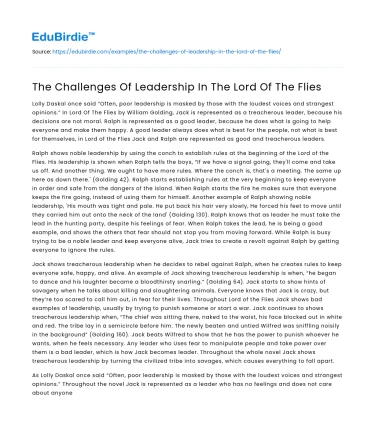Lolly Daskal once said “Often, poor leadership is masked by those with the loudest voices and strangest opinions.” In Lord Of The Flies by William Golding, Jack is represented as a treacherous leader, because his decisions are not moral. Ralph is represented as a good leader, because he does what is going to help everyone and make them happy. A good leader always does what is best for the people, not what is best for themselves, in Lord of the Flies Jack and Ralph are represented as good and treacherous leaders.
Ralph shows noble leadership by using the conch to establish rules at the beginning of the Lord of the Flies. His leadership is shown when Ralph tells the boys, “If we have a signal going, they'll come and take us off. And another thing. We ought to have more rules. Where the conch is, that's a meeting. The same up here as down there.' (Golding 42). Ralph starts establishing rules at the very beginning to keep everyone in order and safe from the dangers of the island. When Ralph starts the fire he makes sure that everyone keeps the fire going, instead of using them for himself. Another example of Ralph showing noble leadership, 'His mouth was tight and pale. He put back his hair very slowly, He forced his feet to move until they carried him out onto the neck of the land' (Golding 130). Ralph knows that as leader he must take the lead in the hunting party, despite his feelings of fear. When Ralph takes the lead, he is being a good example, and shows the others that fear should not stop you from moving forward. While Ralph is busy trying to be a noble leader and keep everyone alive, Jack tries to create a revolt against Ralph by getting everyone to ignore the rules.
Save your time!
We can take care of your essay
- Proper editing and formatting
- Free revision, title page, and bibliography
- Flexible prices and money-back guarantee
Jack shows treacherous leadership when he decides to rebel against Ralph, when he creates rules to keep everyone safe, happy, and alive. An example of Jack showing treacherous leadership is when, “he began to dance and his laughter became a bloodthirsty snarling.” (Golding 64). Jack starts to show hints of savagery when he talks about killing and slaughtering animals. Everyone knows that Jack is crazy, but they’re too scared to call him out, in fear for their lives. Throughout Lord of the Flies Jack shows bad examples of leadership, usually by trying to punish someone or start a war. Jack continues to shows treacherous leadership when, “The chief was sitting there, naked to the waist, his face blocked out in white and red. The tribe lay in a semicircle before him. The newly beaten and untied Wilfred was sniffling noisily in the background” (Golding 160). Jack beats Wilfred to show that he has the power to punish whoever he wants, when he feels necessary. Any leader who Uses fear to manipulate people and take power over them is a bad leader, which is how Jack becomes leader. Throughout the whole novel Jack shows treacherous leadership by turning the civilized tribe into savages, which causes everything to fall apart.
As Lolly Daskal once said “Often, poor leadership is masked by those with the loudest voices and strangest opinions.” Throughout the novel Jack is represented as a leader who has no feelings and does not care about anyone else’s feelings, and Ralph is represented as a leader who cares about the happiness of the tribe. After Ralph teaches everyone how to be civilized, Jack almost turns everyone into savages until they are found and rescued by a sailor.






 Stuck on your essay?
Stuck on your essay?

